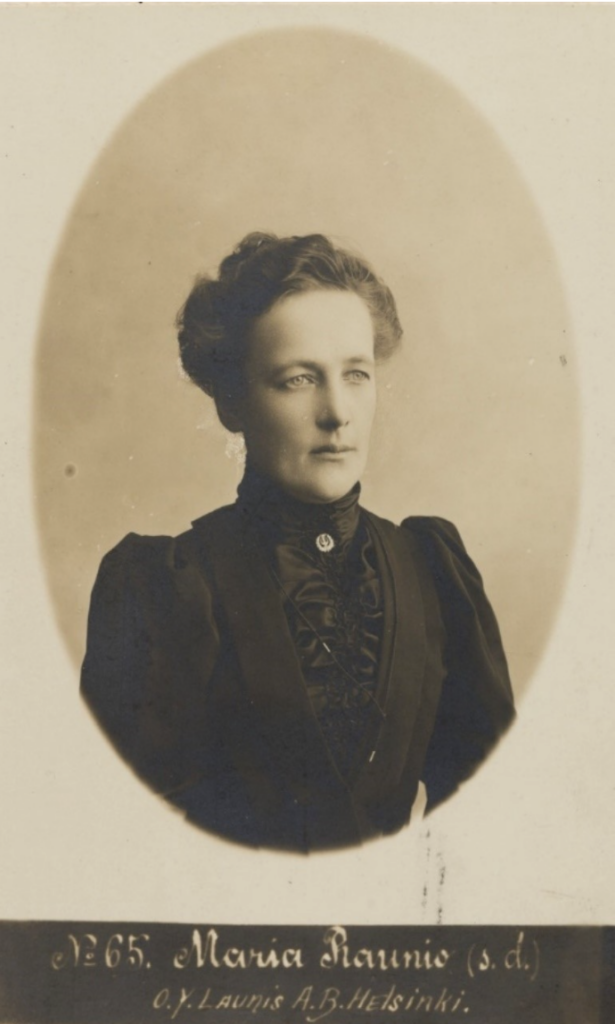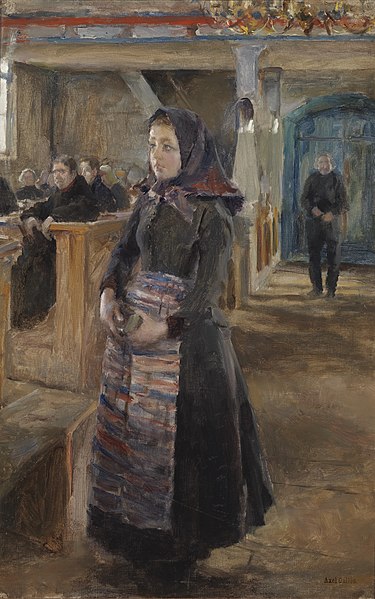by Pirita Frigren, University of Turku, Finland
(Keuruu Museum Director, June 2022−May 2023)

Picture: Maria Raunio, Member of the Finnish Parliament, 1907. Photo: Launis Oy/ Finnish Heritage Agency CC BY 4.0.
When I started my job as a museum director in the city of Keuruu in Central Finland in summer 2022, I soon came across the name of Maria Raunio (née Saarinen, 1872−1911). In the first place this happened when I was wandering about on a scenic footpath by the lake Tarhia, near the Keuruu city center. On 26 May 2017, this 700-meters-long beautiful lakeside trail was named after Maria Raunio as a commemoration of her 145th birthday. This was also the year when Finland was celebrating its 100 years of independence with a great number of history and culture festivities. As a result, the street now carries the name Maria Raunio Trail, in Finnish Maria Raunion polku (the path can be found on this map as attraction number 7 provided by the Keuruu city free time services). Who was this woman and why was she so important that a landmark was dedicated to her? Soon I learnt that not only was she an interesting person in the Finnish feminist and labour movement history but she was also a migrant and her monument could thus be included to the interactive Map of Women Migrants’ Landmarks on the WEMov website with a good reason.
Maria Saarinen was born as a first child to tailor Erland Saarinen and service maid Kristiina Hellen in Keuruu in 1872. Maria was followed by as many as 13 siblings, yet six of them died as small children. As a part of the local landless population, the family was first given a place for their home cottage on a land owned by the Keuruu vicarage. Although the household was large and there were few sources for the living, Erland and Kristiina managed to run Erland’s tailor workshop successfully, and in the early 1880s they moved to an own house located by the lake Tarhia, today a blockhouse and a swimming beach.
The Saarinen family was religious, hard-working and up for new education possibilities that the new elementary school system (resulting from the Elementary School Act of 1866) provided for all the children despite their social class in Finland. All the children in the Saarinen family were allowed to go to school. In 1889, Maria was 17 years old when there was a big summer festival organized by the well-known Finnish cultural elite such as the Järnefelt noble family who used to spend their summer time in Central Finland near Keuruu. The event was a charity operation for a new municipal hospital and one of the event highlights was a theater play called Amalia ystävämme (‘Our Friend, Amalia’). Maria was the only local person who acted in the play. As Keuruu was then visited by numerous national intelligentsia and artists, Maria Saarinen also met the young rising visual artist Akseli Gallén (later known as Akseli Gallén-Kallela, 1865−1931). Gallén asked Maria to pose for him in the Keuruu old church, which led to the famous oil painting entitled ‘The Girl in the Keuruu Old Church’ (Tyttö Keuruun kirkossa in Finnish). The artwork now belongs to the Gösta Serlachius Fine Arts Foundation’s collection.

Picture: Akseli Gallen-Kallela( 1865 – 1931). A Girl in the Old Church in Keuruu (1889), oil on canvas: 65 × 42.5 cm. Gösta Serlachius Fine Arts Foundation / Yehia Eweis
Despite this mingling with the national culture elite, Maria Saarinen was trained to an ordinary working-class occupation typical for young women. She started to work as a seamstress and met Kalle (Kaarle Kustaa) Flinta who had come to Keuruu to work on construction site of the new church. Although Kalle was married and had a family in his home parish, the couple fell in love and Maria got their first baby in 1893. Later, they got married, took a new surname Raunio, and got seven children altogether – yet again like Maria’s parents, so also did Maria and Kalle lose some of their descendants as infants because of the high underage mortality of the time.
The Raunio couple was active in the local labour movement. However, Maria’s life witnessed a new turn when Kalle decided to move to the U.S.A. in 1904 in order to work as a miner in Indiana. Supposedly, the plan was that Maria and the children would follow Kalle and migrate across the Atlantic later. This plan was never realized as Kalle died accidently only within a year.
Stricken by widowhood and poverty, Maria Raunio decided to leave her children at her parents’ place and she moved alone to Tampere which was a newly industrialized city and provided working possibilities. Maria found a job as a secretary in a labour movement magazine and gradually she was also introduced with the women’s rights and women’s suffrage movements. This is how she soon became more active in politics and as the first Finnish Parliamentary Election was carried out in 1907, Maria Raunio was elected to Member of the Parliament among the first female M.P.s. She represented the Social Democratic Party as an M. P. from 1907 to 1910. Maria Raunio is known to have promoted many important topics as a politician. She took initiatives in hiring professional municipal midwives, building mental hospitals and institutions for tuberculosis patients, as well as organizing food and clothes for the poor school children.
Maria Raunio failed to renew her post as an M. P. in the next parliamentary election and in 1910, at the age of 38, she made the undoubtedly hard decision to leave her parents and children and emigrated from Finland in order to work in the U.S.A. She first moved to Massachusetts where she married a Finnish migrant man, [his first name was probably John Nestor] Aaltonen. However, this marriage soon ended up in a divorce. Maria continued further to the west and settled in Astoria, Oregon, where she was recruited to launch and edit the new socialist and feminist Finnish-language newspaper Toveritar. The newspaper was later popular among the Finnish American migrants and it was distributed even to Canada. However, the first months were hard for a new paper and Maria struggled to get enough readers. Her life came to a sudden and sad end in September 1911 when 39 years old Maria Raunio (Aaltonen) was found dead in her boarding house dorm. The death was suspected to have resulted from an overdose of sleeping pills.
Maria Raunio undoubtedly lived stressful years after her widowhood and most certainly also had to face many disappointments as a labour movement and women’s rights activist, and finally also in serving the Finnish American migrant community in the Pacific West. One of the hardest things must have been leaving her small children to the home district in Keuruu due for financial and political reasons. Her youngest son was only eight years old when Maria Raunio faced her early death. Yet, it is because of her hard life, hard efforts and because of her pivotal part in the history of women’s suffrage and participation in the democratic decision-making in Finland that it is important that we remember who she was and why it is a precious that Maria Raunio has been dedicated a landmark in one of the most central and beautiful lakeside neighborhoods in her birthplace Keuruu.
References:
Katainen, Elina, Waloon ja wapauteen!: kansanedustaja Maria Raunio. In Markkola, Pirjo & Alexandra Ramsay (eds.), Yksi kamari – kaksi sukupuolta: Suomen eduskunnan ensimmäiset askeleet [One Chamber – Two Genders: the First Years of the Finnish Parliament], Helsinki: Eduskunnan kirjasto 1997, 45−62.
Moisio, Tomi, Artwork Description, Akseli Gallén-Kallela: The Girl in the Keuruu Old Church (1889), oil on canvas. Gösta Serlachius Fine Arts Foundation, (visited on October 1, 2022).
“Maria Raunion polku,” Keuruun Veräjä, (visited on October 1, 2022).
“Raunio, Maria,” Keuruun Veräjä, visited on October 1, 2022.
Ruusila, Liisa, Maria Raunio − Astorian perhonen (1872−1911) (visited on October 1, 2022).